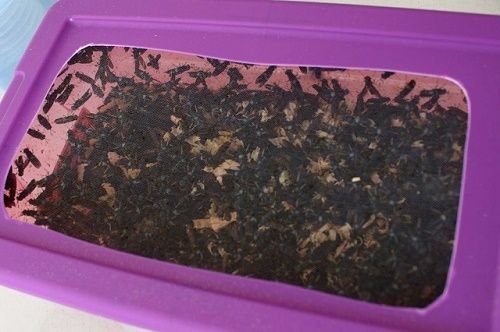
The growing demand for fishmeal as a protein source for feeds used in the aquaculture industry has raised concerns about sustainability and resource depletion. Black soldier fly meal (BSFM), derived from the larvae of the black soldier fly, has emerged as a potential alternative due to its high protein content and efficient production. However, the impact of BSFM on fish growth, health, and behavior remains an ongoing area of research.
A team of researchers from Minas Gerais Federal University (UFMG), Viçosa Federal University (UFV), and Lavras Federal University (UFLA) investigated the effects of black soldier fly meal (BSFM) as a protein substitute for fishmeal (FM) in juvenile Nile tilapia. The research, published in the journal Aquaculture Research, focused on the fish’s dietary preferences, growth performance, body composition, blood parameters, and the expression of immune-related genes.
The Potential of Black Soldier Fly Meal
BSFM offers a promising solution to the challenges posed by FM. Studies have shown that BSFM has a similar amino acid profile to FM, making it a suitable protein source for aquaculture. Additionally, BSFM is produced from insects that can be raised on organic waste, reducing environmental impact compared to traditional livestock farming.
Several studies have investigated the effects of including BSFM in aquaculture diets on fish growth, performance, and health, particularly in tilapia. While some studies have reported positive outcomes, such as improved growth rates and reduced feed costs, others have found more mixed results. The variability in outcomes may be attributed to factors such as the nutritional quality of BSFM, experimental conditions, and the level of dietary inclusion.
The Importance of Palatability
An important factor influencing the success of BSFM in aquaculture diets is palatability. While BSFM is generally well-tolerated by fish, some studies have suggested that it may negatively impact feed intake due to its organoleptic properties. However, palatability can be improved through processing techniques or by combining BSFM with other ingredients.
Feed Preference Research
By allowing fish to choose their preferred diets, researchers can gain insights into the factors driving their food choices, including palatability, nutritional content, and health status.
The researchers conducted two experiments to evaluate the effects of BSFM in Nile tilapia:
- In Trial 1, 60 juvenile Nile tilapia were randomly distributed into 60 aquariums and presented with a choice of six different diets containing 0%, 33%, 66%, and 100% BSFM as a protein substitute for FM. The fish were allowed to select their preferred diet over 32 days.
- In Trial 2, 240 juvenile Nile tilapia were fed experimental diets containing 0%, 33%, 66%, and 100% BSFM for 2 months. Growth performance, body composition, blood parameters, and the expression of immune-related genes were evaluated.
Results
The results indicated that Nile tilapia could tolerate up to 66% BSFM in their diet without significant negative effects on growth performance. However, the fish showed a clear preference for diets containing 33% BSFM. Higher inclusion levels of BSFM led to reduced growth rates, lower feed efficiency, and changes in blood parameters, including reduced levels of total cholesterol, triglycerides, and albumin.
Stay Always Informed
Join our communities to instantly receive the most important news, reports, and analysis from the aquaculture industry.
The analysis of immune gene expression revealed that BSFM inclusion had minimal effects on most immune-related genes. However, the expression of the inflammatory cytokine interleukin-1β (IL-1β) was elevated in fish fed diets with 0% and 100% BSFM, suggesting potential immune responses to dietary changes.
Implications for Tilapia farming
The findings of this study suggest that BSFM can be incorporated into Nile tilapia diets as a partial replacement for fishmeal without compromising growth performance. However, optimizing the inclusion rate is crucial to ensure optimal fish health and productivity. The observed preference for diets containing 33% BSFM may be attributed to factors such as palatability, nutrient bioavailability, or digestive enzyme activity.
Further research is needed to investigate the long-term effects of BSFM on tilapia health, reproductive performance, and product quality. Additionally, exploring strategies to enhance the nutritional quality of BSFM, such as through fermentation or enzymatic treatments, could improve its suitability as a fish feed ingredient.
Conclusion
This study provides valuable insights into the potential of BSFM as a sustainable protein source for Nile tilapia aquaculture. While BSFM can be effectively incorporated into tilapia diets, it is essential to carefully consider inclusion rates and potential immune responses. Future research should focus on optimizing BSFM utilization to maximize its benefits for fish health and productivity.
The study was funded by CNPq (National Council for Scientific and Technological Development).
Contact
Leandro Santos Costa
Department of Animal Science , Viçosa Federal University (UFV)
Avenue Peter Henry Rolfs, s/n—Campus Universitário, Viçosa, CEP 36570-900, Minas Gerais, Brazil,
Email: leandro.s.costa@ufv.br
Reference (open access)
Freitas, A., Perez Ribeiro, P. A., Costa Teixeira, R. R., Gamarano, P. G., Landa Prado, V. G., Guilherme, O., Paulino, R. R., & Costa, L. S. (2024). Impact of Replacing Fish Meal With Black Soldier Fly (Hermetia illucens) Meal on Diet Acceptability in Juvenile Nile Tilapia: Palatability and Nutritional and Health Considerations for Dietary Preference. Aquaculture Research, 2024(1), 3409955. https://doi.org/10.1155/2024/3409955
Editor at the digital magazine AquaHoy. He holds a degree in Aquaculture Biology from the National University of Santa (UNS) and a Master’s degree in Science and Innovation Management from the Polytechnic University of Valencia, with postgraduate diplomas in Business Innovation and Innovation Management. He possesses extensive experience in the aquaculture and fisheries sector, having led the Fisheries Innovation Unit of the National Program for Innovation in Fisheries and Aquaculture (PNIPA). He has served as a senior consultant in technology watch, an innovation project formulator and advisor, and a lecturer at UNS. He is a member of the Peruvian College of Biologists and was recognized by the World Aquaculture Society (WAS) in 2016 for his contribution to aquaculture.




